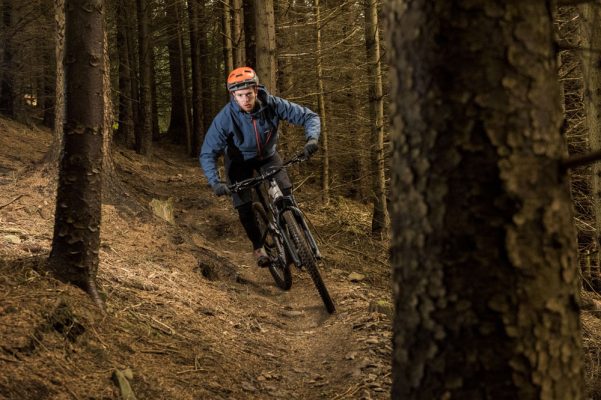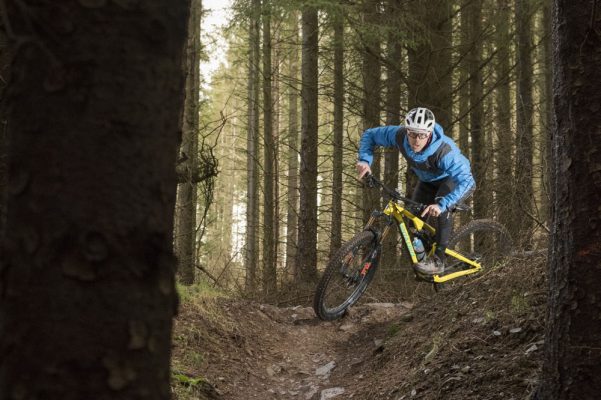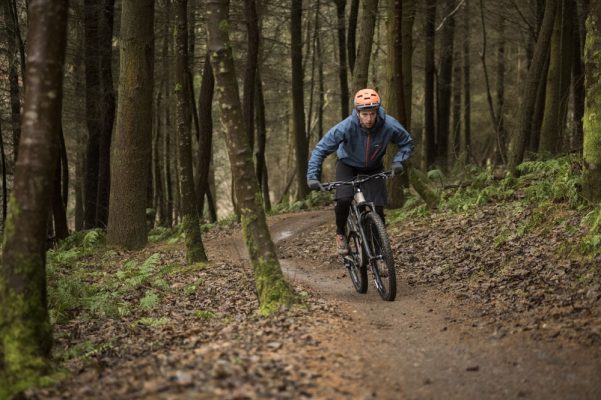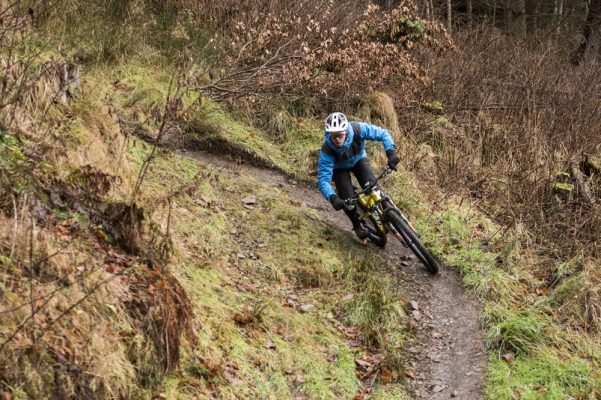The secrets to going quicker might be easier than you think
We all want to go faster, but how do some riders make it look so easy? How can we stay calm and fluid when everything around us is becoming more stressful?
>>> How to exit corners with more speed
This month Andy from Dirt School looks at the secrets to going faster. Andy takes Matt, a confident recreational rider, through his paces and look at some of the tricks that will allow him to go quicker without even trying.
Words by Andy Barlow

1. Confident body position
You know it already, but we cannot stress this enough. Having a low, confident body position is essential to staying in control. As soon as you start pushing your limits it will be the first thing that will become compromised, so being conscious that you need to keep coming back to it will be at the heart of staying in control. Your arms should remain bent at the elbows, your head over the bars, back flat, and remember that the disconnect that will allow you to balance should be at your hips and knees not at your head and shoulders. Cracking this ‘go to’ body position at all speeds, and on all surfaces and gradients, will allow your front end to stay neutral and give you the confidence to push on.
Matt says: “After my last session I feel like my body position is is pretty good. I have noticed though that it starts to get lazy once I’m tired though. I keep having to remind myself to stay low over the front on longer days.”

2. Braking zones
Once you pull your brakes two major things will happen. The most obvious is that you’ll start to lose traction as your tyres will be working harder to slow you down. The less obvious one is that you’re arms will go stiff. This is because as you lose speed they’ll be the things stopping your body from lunging forwards. This is fine if you’re on smooth ground, but if you’re already on features where you’re arms and legs are having to move to keep you neutral, it will be hard to stay fluid while you’re on the brakes. Instead, try and pick your safe braking zones so that you can do all your slowing down on safer terrain. That way you can stay off the brakes and enjoy a lot more control when you’re on the rougher stuff.

3. Exit speed
What’s the most important thing about any section as you start to go faster? The answer is always exit speed. You can gain so much time on your mates by just calming down on the way in to a corner, riding it well, and leaving with confidence. For most riders this is almost impossible as they’ll feel like they’re going so much faster if they leave their braking as late as possible, slide through on the limit of what they can handle, and try as hard as they can to get back up to speed. While this may feel like you’re riding your bike to it’s limit, the reality is that you’ve just stalled on the track and you’re wasting a lot of energy getting back up to speed. Instead try and take your time on the way in and set up on a line so that you can stay off the brakes as you go through.
Matt says: “The lines Andy was taking on the way in to things was insane, but once I tried them they were no problem at all. I’d normally be the rider hammering up the inside and locking my back wheel in the middle. Now I can feel my bike accelerate the whole way through and I’m not even trying.”
4. Take your time
This is just a fancy way of stating how fast something feels. It’s a tough one to crack as you’ll always be gauging how fast you’re going on the feedback from the trail, but remember that speed comes from confidence through control. It takes time and confidence to trust this strategy, but if you apply it on the clock it will mean that you can save your efforts for where you can make more of a difference. If you consider yourself a fit rider then you’re probably putting hard pedal strokes in out of every corner. This might feel like you’re getting up to speed, but you’re wasting a lot of energy in the process. Take your time and set up well on the way in to sections for the best results.
For Matt this was another game changer. “Taking my time over braking and setting up on wider lines feels like I have more time to react in the corner. It means that I can accelerate the rest of the way round and I’m basically carrying more speed without even trying!” It’s not uncommon for riders to feel like they’re going slower but to have better runs than when they were trying to go fast!
5. Pacing zones
In a nutshell, you should feel in control on the technical sections, be carrying speed out of corners, and saving your pedal strokes for where you can really turn up the effort. Try splitting your trails into pacing zones. We find gradient works well here, with red, amber and green. Red means back off. It’s likely steep, technical and full of places where you can make major mistakes. Ride it clean. Amber means stay calm. You’re probably going faster, but concentrate on riding smooth and carrying speed. Remember and save your energy. Green means go wild! This is more like a flat fire road, a pedally climb, or a part of open ground where you can make a real difference going hard out of the saddle. If you’re already tired by the time you get here then you’ll have nothing left to contribute. If you arrive at a Green zone fresh you can bury yourself in the effort and make up loads of ground on everyone else that will be rolling in to it already burst.

6. Fitness
A major contributing factor in going fast is your fitness. You can split this in to two main areas; your cardiovascular fitness which allows you to pedal uphill and stay fresher for longer, and your overall strength that will allow you to ride technical sections well. The more time you spend on your bike the easier both of these will become. For your fitness, why not try cycling to work, or riding more XC, cyclocross or road through winter. For general strength there’s always the gym. It’s always better to practice new techniques on terrain that you already know well so that you’re not close to your limit. The more smaller loops you can do well, the easier it will be to progress on to more demanding or newer terrain. If your time is limited though you can always make the most of what you’ve got by following our pacing strategy.
Matt says: “Riding cyclocross and road has made a massive difference to my fitness over the last couple of years. With less stress on my body I can concentrate on my technique way more than before. It means I can do proper epic routes and stay fresh right till the end.”

7. Control the controllables
There are certain things that are well within your control. Conversely, there are other things that you will never be able to influence. A big part of riding fast is your own confidence and we’d say that this also extends to your general mindset. The classic here is bad weather. You have absolutely no control over whether it’s sunny or wet, but a lot of riders will allow a sudden change in the weather from dry to wet to completely ruin their ride. Instead, try and focus on the things that are in your control; can you fit a mudguard? Can you change your tyres? Should you change the lines you’re taking into sections to play it safe? Or even change the route that you’re on to cut a bit off? If you concentrate on the things that are within your control you’ll soon forget about the things that aren’t, allowing you to stay in a much more positive frame of mind and be capable of much clearer decisions that will allow you to go faster.

8. Bike set-up
As you start to go faster you might need to toughen up your set up. Even just being more deliberate in your body position will mean you’re putting more weight on your front end. The faster you hit things the harder your suspension will need to be to stop bottoming out. Even experimenting with how much ramp your suspension has will mean you avoid those harsh slams as you bottom out. Meanwhile, you want to keep your tyres soft enough that they give you maximum grip, but a few extra PSI in the rear might mean you get less pinch flats. Being clipped in will also make a difference to how you pedal. This will also allow you to stay put over the rough stuff with one less thing to think about when you’re going fast.

9. Set goals
You don’t have to tell anyone that you’re doing this, but an incredibly healthy thing to do as a mountain biker is to set yourself some goals. This might be to work on a particular aspect of your riding, it could be to ride a new trail that you’ve heard of, or even to enter an event that pushes your limits. Whatever you set as your goal, make a plan and stick to it. One of the most satisfying things about riding is making progress, and seeing that progress happen on a regular basis will keep you coming back for more for years to come.
“Have a plan and stick to it. It’s that simple.” says Matt.
10. No pedalling
Pick a trail that you ride regularly and try riding it with no pedal strokes. This will really make you think about where you’re pumping for momentum, where you’re braking, and what lines you’re taking to carry more speed out of sections. It’s a great way to test whether or not you’re using technique to get yourself back up to speed, or if you’re relying on pedal strokes which will eventually tire you out. You might not get any KOMs riding like this, but you’ll look at the same trail in a new light after you’re done it with ‘nae pedises’.



